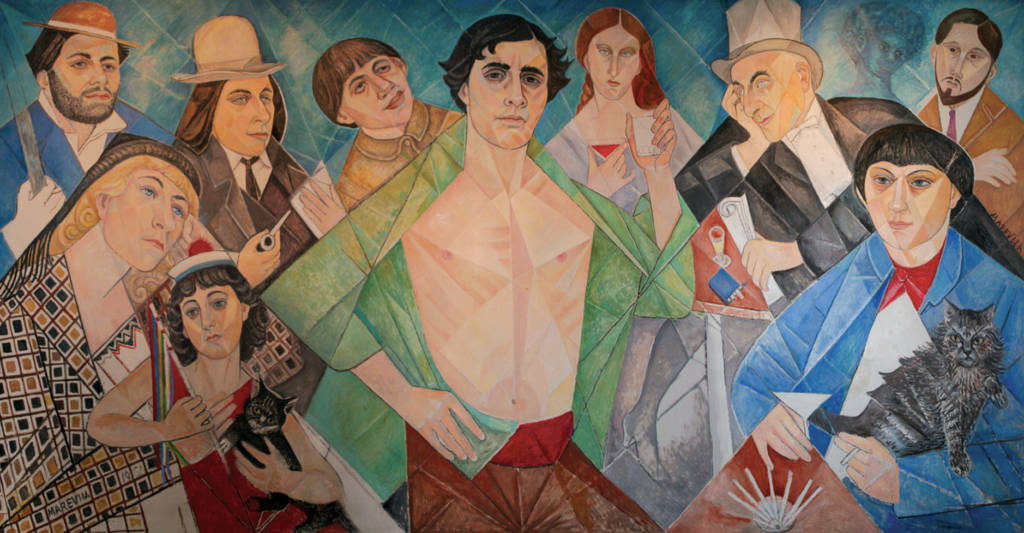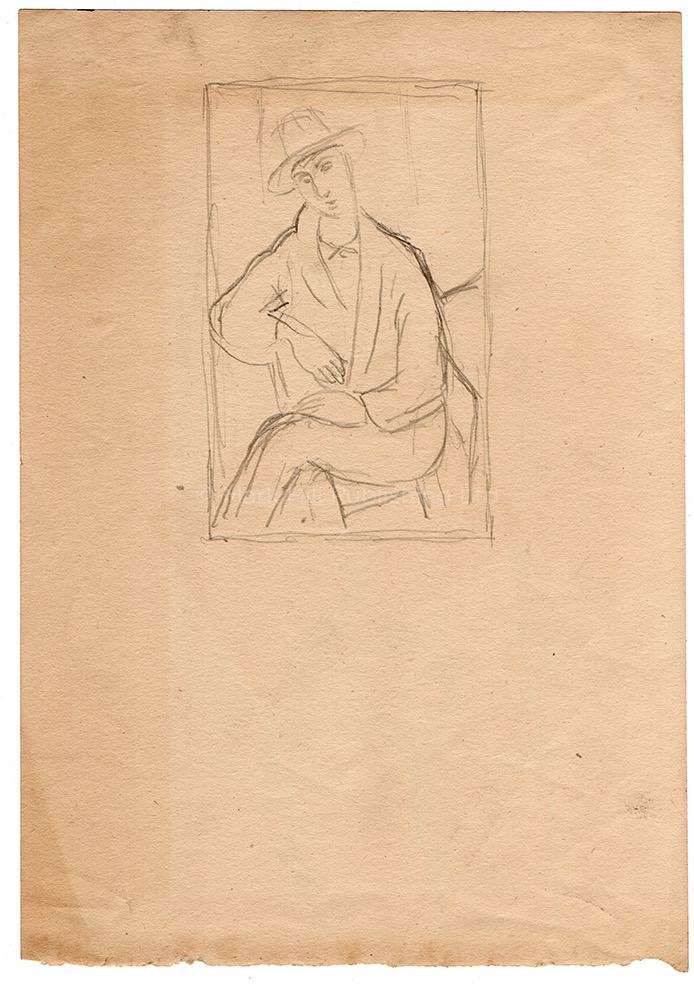I didn’t want to die at 36, but to a young art history student living away from home for the first time, Amedeo Modigliani’s life (1884-1920) seemed dramatic, charismatic, exciting and bohemian. I loved (and still love) his art and set myself a challenge of one day owning something directly connected to it and him – however tenuously. After all, I could hardly afford something actually by him, with the last painting by him sold at Sotheby’s fetching over $157million, and with one of his many drawings costing anything from £20,000 to over $500,000. However, some 25 years later, I have managed it. And, now I’ve done my research, the link between the artist himself and what I bought isn’t as tenuous as I thought it would be back then as a student. In fact, it has way surpassed it.

Reading through the Antiques Trade Gazette in November 2018, my eye and mind were caught by an advertisement for an auction at Rosebery’s the following month of the remains of the studio of an artist called Marevna, who was also known as Marie Vorobieff-Stebelska (1892-1984). The advert showed drawings by her that included Modigliani and many of his (now famous) artist friends. Although I had read every book on Modigliani at university, Marevna’s name was not one from his circle that had stood out to me at the time. Looking deeper, Marevna (best known as ‘the first female Cubist’) turned out to be a fascinating personality and artist.
Born in Russia, she lived within and around the mercurial artistic community of La Ruche in Paris from 1912 until she moved to the south of France in 1936. In 1919 she began a deep and torrid two year relationship with the Mexican artist Diego Rivera (1886-1957), which bore them their daughter, Marika. Amongst this progressive artistic group, she was very close to the poets Max Jacob and Max Voloshin, the artists Chaim Soutine and Ossip Zadkine, and the writer Ilya Ehrenburg. Her wider circle led her to attend the group’s legendary wild parties, hang around with the likes of Pablo Picasso, Juan Gris and others – and befriend Modigliani.
One of her autobiographies, ‘Life in Two Worlds‘ (Abelard-Schuman, 1962), offers an incredible firsthand insight into this group, as well as her life and work, and includes details about her friendship with Modigliani. Numerous other sources mention that she used to take him wine and he used to sketch her, and a number of these drawings of her by Modigliani survive today. She certainly painted and drew him frequently as the number of surviving works by her of him attest to. So I was intrigued by lot 43 in Rosebery’s auction, which I bid for and won. It’s a pencil on paper sketch by Marevna of one of Modigliani’s portraits (below) from 1920, of the Greek composer and musician Mario Varvogli (1885-1967). On the reverse of the sheet of paper is a further sketch by her of a reclining nude – one of Modigliani’s most celebrated and most desirable subjects.

Going back to my Modigliani books after winning to find out as much as I could revealed some fascinating information. I started with and focused on both Varvogli, arguably a marginal character in the School of Paris group, and on Modigliani’s portrait of him.
No biographies of Modigliani mention Varvogli before late 1919. The biographers William Fifield and June Rose say Modigliani sketched Varvogli when they were drinking together with a group of Greek friends in a cafe in Rue Joseph-Bara on New Year’s Eve 1919 and New Year’s Day 1920 (Fifield p280, Rose p208). At the time, Varvogli and Modigliani would have been about the same age – around 35. Modigliani added a hopeful inscription to one of his drawings of Varvogli made that night and day that is very similar in format to the subsequent painting – “Il Nuovo Anno. Hic Incipit Vita Nuova. (The New Year. Here begins a new life.)”
He then executed a number of further sketches and preparatory studies, as he always did, painting the oil on canvas portrait of Varvogli (left) in the first two weeks of 1920. By late January, Modigliani was dead.
Marevna observes in her biography that winter in Paris that year was brutally cold, and Modigliani had been very ill since November 1919. Ever the alcoholic, drug-taker, and rampant party animal, he was reportedly, drunk, cantankerous, seriously ill and entirely self-destructive that winter – every part the Modigliani of legend. He was arrested for drunken behaviour “almost every night” (Rose p210).
Differing opinions on the events of his last few weeks exist (Rose p211), but he developed a painful kidney problem on 14th (or 18th) of January, and went to bed after being diagnosed with nephritis by a doctor. Four days later, after he developed head and temperature pains and his condition became more serious, he was taken to hospital unconscious. He never left the hospital alive, as he died of tubercular meningitis several days later on 24th January 1920, at 20.50. He was buried on 27th January 1920. The day before his funeral, Jeanne Hébuterne, his wife and erstwhile muse who was five months pregnant with their second child, threw herself to her death from the fifth floor of her parents’ house. A terribly tragic end, it goes without saying.

The portrait of Mario Varvogli was thus the last work Modigliani ever painted. According to Fifield (p280), “…the painting was still on the easel, not yet dry.” when the artist Jean Zavado entered Modigliani’s studio on the Rue de la Grande-Chaumière to clean up after his death. Chantal Quenneville, a friend of Jeanne Hébuterne who also visited the studio then, said “On the easel was a beautiful portrait of a man, unfinished.” (Fifield p283). It is generally considered as one of his most mature works – the biographer Pierre Sichel described it as a “fine, finished painting with all the psychological insight that even a Paul Guillaume may have wished for. What is outstanding, considering Modi’s physical condition at the time, is that no deterioration is evident in the work. The portrait is hard and firm, clean and precise, well organised and composed – as good as any Modigliani.” (Sichel, p530).

Almost immediately after Modigliani’s death, prices for his work spiralled upwards as ‘Modigliani Mania’ took hold. His work and anything connected to it and him became hotly desirable. His palette and brushes were sold for 150 francs to an American and, at Modigliani’s funeral, mercenary dealers offered Léopold Zborowski (Modigliani’s dealer) five times the asking price for his works, despite Zborowski’s obvious grief. We do not know what happened to the portrait of Varvogli in these weeks and months, but it was not likely to have remained in Modigliani’s locked studio for long, particularly after his younger brother Emmanuele arrived to deal with what remained of his brother’s belongings.

So back to my drawing by Marevna, and a closer look at the timings in play here. The drawing is clearly based on and was derived from Modigliani’s painting. Varvogli is posed in the same manner as in the painting, he wears the same clothes and hat, and sits in front of the same door and wall – reduced to their essentials, but still unmistakably there.
We know that the initial impetus for the painting, and the first sketches Modigliani produced for it, came from the party attended by Modigliani and Varvogli on 31st December 1919 and 1st January 1920. Modigliani took to his bed either 14 or 18 days later, before falling unconscious four days later and being taken to hospital. So that places firm bookends for the start and end of the creation of the painting – and Marevna’s drawing must sit between them.
Before the 31st December 1919, neither the painting nor the format of it can have existed. It is highly doubtful that Marevna would have had much, if any, access to Modigliani’s studio after his death, despite being a friend, and sketching one of his portraits there and then would arguably have been far from her grieving mind.
It is also highly unlikely that she drew this sketch months, or even years, later. What reason would she have to do this? Why this painting in particular? Would she remember the original work so accurately? The paper itself also appears to date from around 1920, as Rosebery’s noted in their catalogue description.
Finally, the format, the choice of subjects, and the fact that there are two sketches on one piece of sketchbook paper all imply that it was also not intended for sale. Marevna doesn’t appear to be the sort of person who would have capitalised on ‘Modigliani Mania’ anyway. It also remained in her possession until her death in 1984.
All of this evidence suggests that Marevna could only have produced her drawing of Modigliani’s portrait of Varvogli in the first 14 or 18 days of January as he executed this, his final painting, before becoming too ill to work. We know that Marevna and Modigliani were friends, so it is most likely that Marevna visited her ailing friend in his studio during the last days of his life as he braved his illnesses and the bitterly cold winter, and deteriorated further due to his drinking and drug-taking. Perhaps she took him wine or food, and stayed to keep him company and watch over him? As she did so, she must have decided to sketch the portrait that was in front of her in his studio.

(255mm x 178mm)
This hypothesis is made even more likely by the presence of the sketch of the nude on the reverse of the sheet of paper (above). The final painting this is based on is Modigliani’s Reclining Nude (below), now in the Museum of Modern Art, New York, which was painted c1919 and must have also still been in his studio at the time.
If I am correct, and I see no reason from the evidence uncovered why I am not, Marevna produced these drawings within this tiny period of time in Modigliani’s studio, in front of these two original paintings – and in his presence. It is thus more than highly likely that Modigliani saw and even handled these drawings. Perhaps they were even amongst the very last works of art he ever handled. As such, they are a tangible and direct link back to this great artist himself, the tumultuous and tragic final days of his life which is known for it self-destructive debauchery, and one of his most mature and characteristic paintings.
Without the ability to buy a work by Modigliani, or a work so closely related to him by his famous companions and friends, what more could the student version of me ask for?
Bibliography
The Studio Collection of Maria Vorobieff Marevna, Rosebery’s London, 5th December 2018
Life in Two Worlds, Marevna Vorobëv, Abelard Schuman, 1962
Modigliani – The Pure Bohemian, June Rose, Constable, 1992
Modigliani – The Biography, William Fifield, Morrow Quill, 1976
Modigliani, Christian Parisot, Terrail, 1992
Modigliani – A Biography, Pierre Sichel, W.H. Allen, 1967
As a final coincidental footnote, I just looked at the date I wrote this article – 13th January 2019 – 99 years to the week after these drawings were produced by Marevna!

